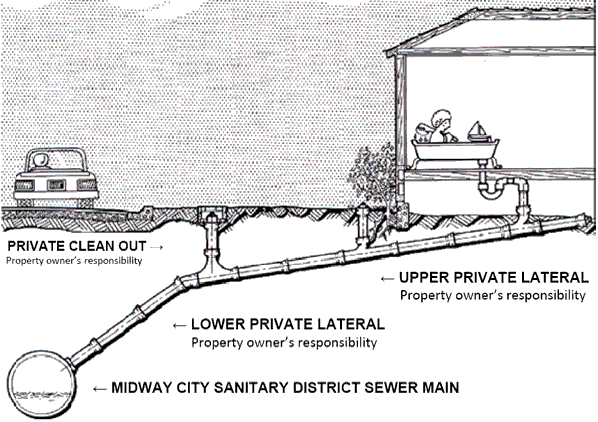Sewer Service Laterals
What Are They and Who Is Responsible for Maintenance?
Private sewer service laterals, which typically are not under the jurisdiction of public wastewater agencies, are not always sufficiently maintained and can contribute to inflow and infiltration (I/I) problems, cause blockages and play a role in sanitary sewer overflows (SSOs).
What is a sewer lateral?
The private sewer service lateral (also known as a private lateral) is a pipe that takes an individual building’s wastewater to the public sewer main in the street. These private laterals are owned by the building owner and are essential for directing wastewater away from homes, churches, schools and businesses to a publicly owned wastewater collection and treatment system.

As illustrated in the diagram, there are both upper and lower private laterals. The upper lateral runs from the home or business to a cleanout at the sidewalk or sometimes the property line. The lower lateral runs from the cleanout to the sewer main in the street. If no cleanout is in place, the private lateral is usually not considered split between upper and lower portions.
Who is responsible for private laterals?
MIDWAY CITY SANITARY DISTRICT GENERAL REGULATION ORDINANCE NO.13 SECTION 19
All house connections, street laterals and appurtenances thereto shall be maintained in a safe and sanitary condition, and all devices or safeguards which are required by the ordinance shall be maintained in good working order. This is the financial reasonability of the property owner. Except as hereinafter provided, all such house connections, street laterals, appurtenances and devices shall be maintained by the owner of the property served thereby.
In California, public agencies are required by the State Water Resources Control Board to manage and maintain the public portion of wastewater systems to minimize the likelihood of sanitary sewer overflows. Regular maintenance of agency-owned sewer lines typically includes scheduled cleaning, inspection and rehabilitation or replacement of defective lines to make them structurally sound and watertight. However, no similar statewide program exists for property owners to regularly clean, inspect and otherwise maintain the private laterals. Most often, property owners only attend to laterals in cases of complete stoppages or emergency failure.
Why are unmaintained sewer laterals cause for concern?
Many older homes still rely on original sewer laterals that over time have become cracked, disjointed or damaged by roots, earth settlement or grease blockages.
Unmaintained private laterals that become blocked or fail can contribute to SSOs of the public sewer system or to sewage backups into the building served by the private lateral. Some of the causes for concern for unmaintained private laterals are described below:
- Root intrusion into the private lateral can contribute to SSOs in two ways. One way is that extra water can enter the sewer system through cracks in private laterals created by roots. This extra groundwater and storm water seeps in or “infiltrates” the public sewer mains, with the potential to cause wastewater collection and treatment system overloads such as SSOs. The other way is when a plumber cleans out a lateral blocked by roots, the plumber sometimes will push the root mass into the public sewer main. This mass can then cause a blockage in the public sewer main, cause wastewater to back up and result in an SSO.
- Earth settlement that results in cracks and leaks in the private lateral allows for the “inflow” of groundwater into the private lateral. This additional groundwater flows into the public sewer main, increases the wastewater flow in the collection system and has the potential to overload the system, creating SSOs.
- If roof drains, irrigation drains and driveway drains are connected (illegally) to the private lateral, this increases the “infiltration” of rain water into the public sewer system, which can lead to system overloads.
- Grease build-up in the private lateral (like plaque in a person’s artery) can cause blockages that potentially result in on-site SSOs or backups of wastewater into the building that is served by the blocked private lateral.
The combination of inflow and infiltration from private laterals, across a wide area (neighborhoods or commercial districts), can significantly increase the wastewater flow in the public sewer main and to the treatment plant. Infiltration and inflow from private laterals are currently a major source of SSOs in some communities.
What is the magnitude of the sewer lateral problem?
The magnitude varies considerably among different systems. It is estimated that private laterals can constitute as much as 50 percent of the total length of all the pipelines in some wastewater systems. Therefore, it is likely that poorly maintained laterals can contribute significantly to I/I problems or produce blockages and resulting SSOs. This is especially true during wet weather if roof or driveway drains are illegally adding flow to the private laterals.
What are strategies for managing sewer laterals?
Property owners should be encouraged to inspect their private lateral upon property transfer and then at least once every five to 10 years to determine if it is defective or if a blockage is building up in the line. If problems exist, a contractor should be hired to correct the problem.
